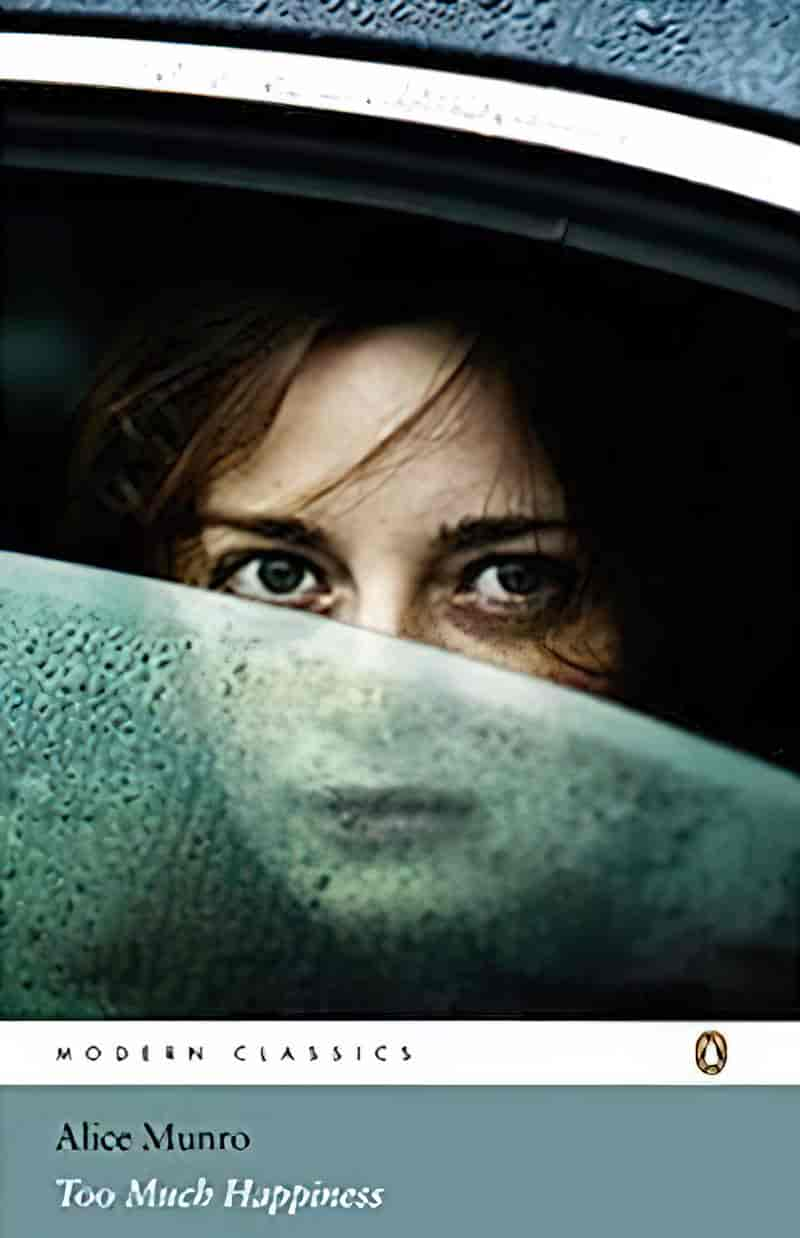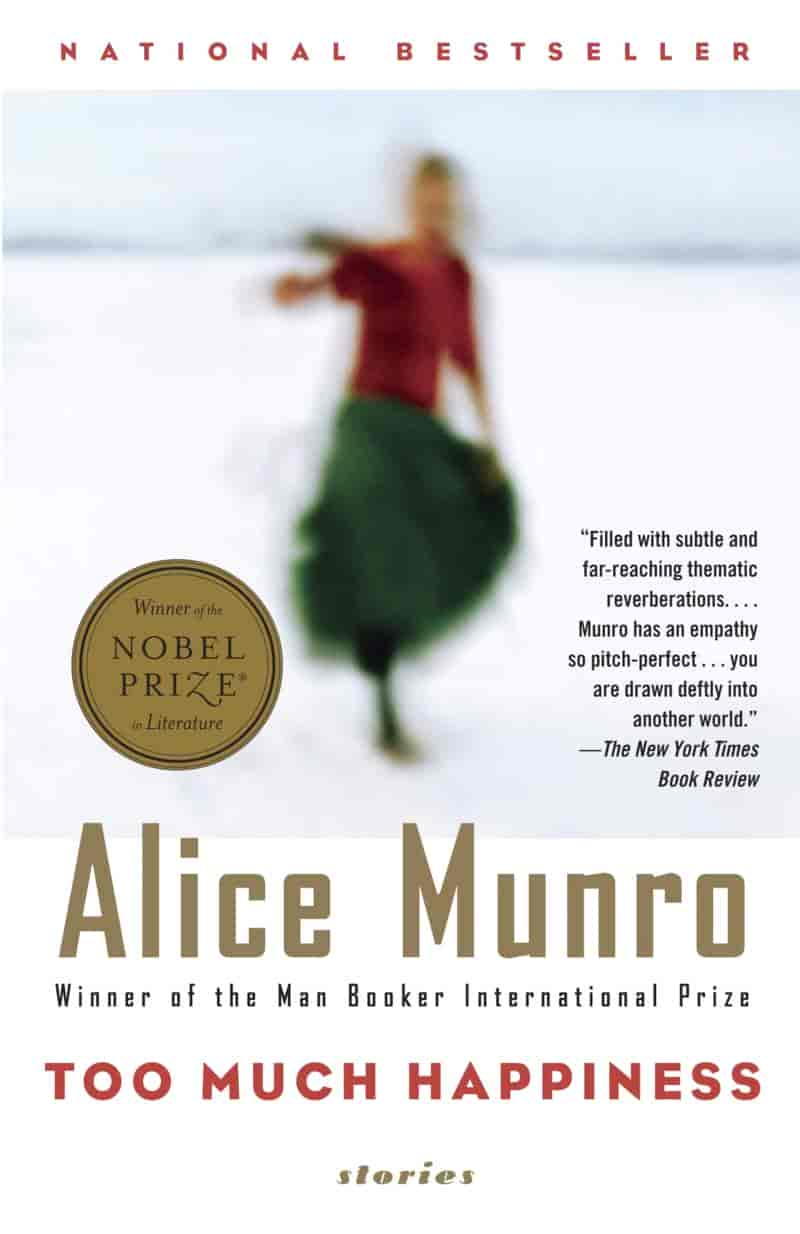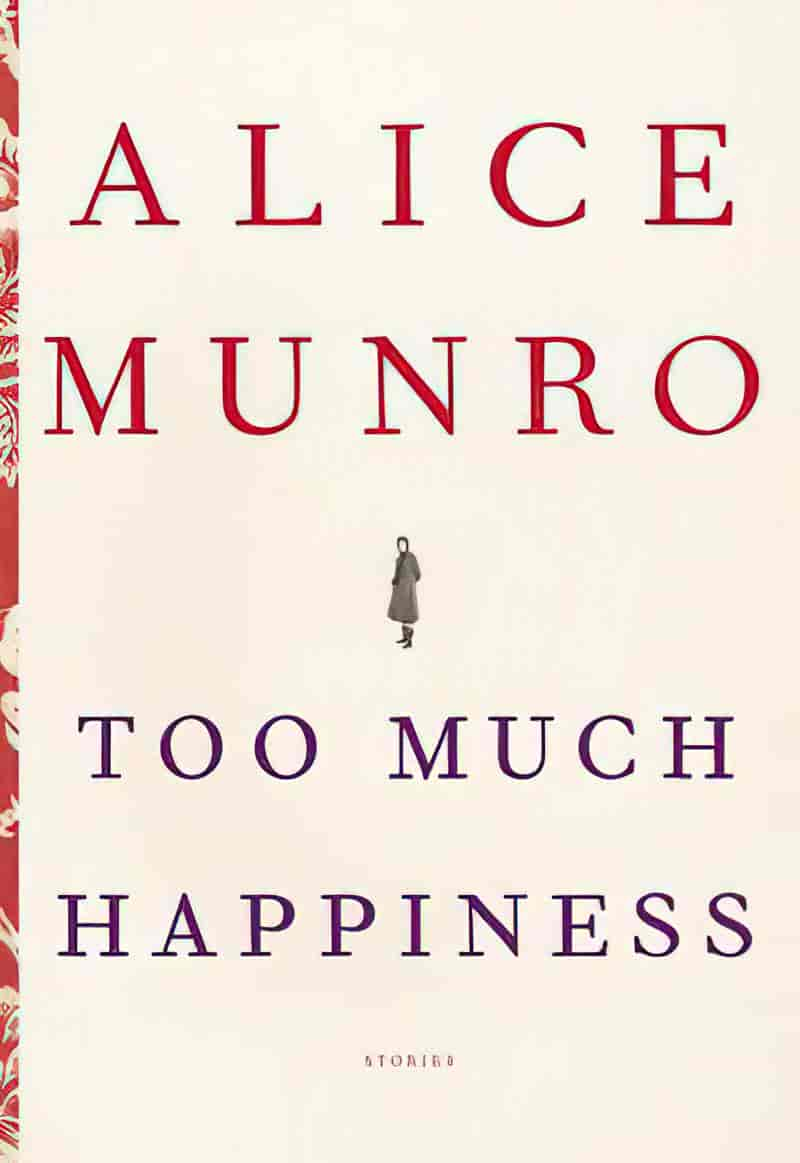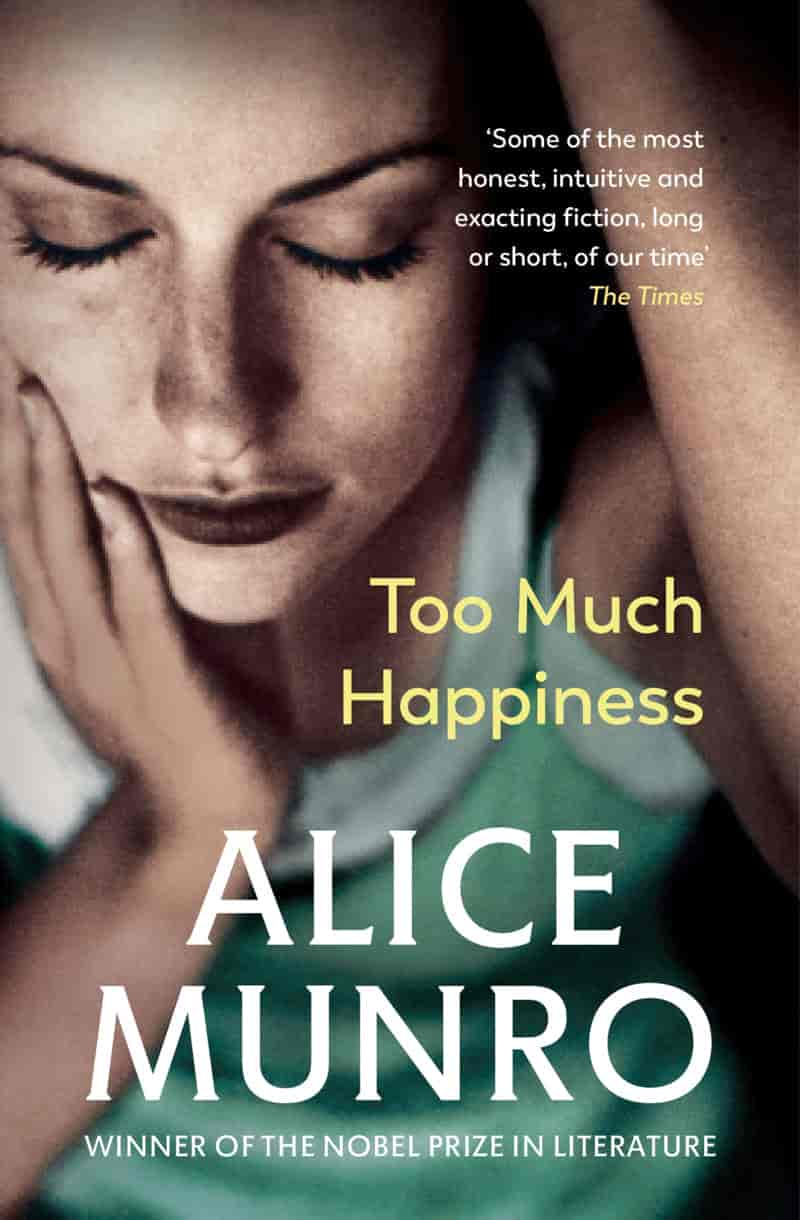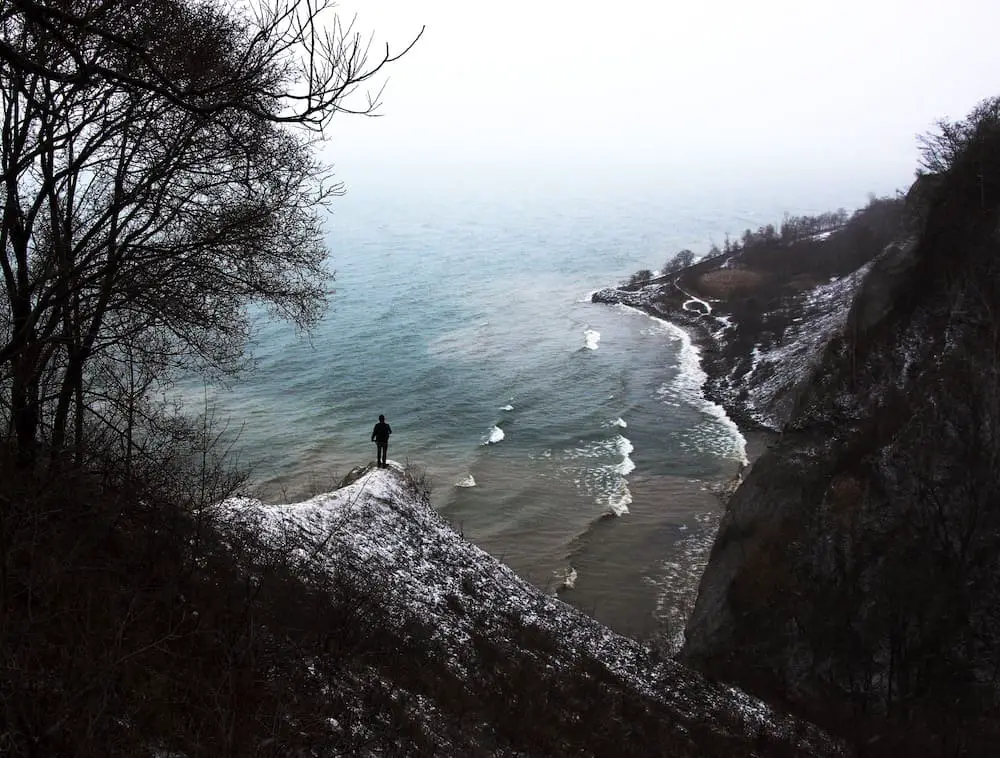“Deep Holes” is a short story by Alice Munro. You can find it in the June 30 2008 edition of The New Yorker. I’m very much reminded of Into The Wild by Jon Krakauer and the real life of Christopher McCandless.
But “Deep Holes” is not the story of the son — it’s the story of the mother, left behind to deal with the loss of a child in this way. How does a mother cope with that?
It follows that this is also a story centred around the emotional labour and mental load of mothers, and how children can grow to resent mothers for it, reserving respect for fathers who do far less.
I’ve heard it said that older people are happier, and this is partly because they have learned to be happy. The rise and fall of happiness over the course of a lifetime is known as the U-bend.
Enjoyment and happiness dip in middle age, then pick up; stress rises during the early 20s, then falls sharply; worry peaks in middle age, and falls sharply thereafter; anger declines throughout life; sadness rises slightly in middle age, and falls thereafter.
The Economist on Medium
This is a story where grief sits alongside a woman’s experience of happiness, which comes in late middle-age.
“We have such numerous interests in our lives that it is not uncommon, on a single occasion, for the foundations of a happiness that does not yet exist to be laid down alongside the intensification of a grief from which we are still suffering.”
Swann’s Way by Marcel Proust, 1913
CAST OF CHARACTERS IN “DEEP HOLES”
Sally
Mother, who at beginning of story has two boys as well as a six month old baby. Her three children have been spaced out. (Similar to Alice Munro’s own children.)
Alex
Sally’s husband, an inconsiderate geologist. Retires but continues his work, using Sally as his assistant. The pair become close during this time as Sally catches his geological curiosity. Later in life he goes into hospital for an operation but never comes home again. (Alice Munro was married to a geographer — a sort of similar line of work, I suppose. This was her second husband. They married in 1976. He died in 2013. Alice Munro’s first husband, James, died in 2016. So although Alice Munro has now lost both great loves of her life, she hadn’t, at time of writing, lost either of them yet.)
Kent
son of about 10-12 with a lot of reckless confidence. In his teen years he decides he’ll become an important scientist. Studies the hard sciences. Very smart kid. Later becomes a monk and changes his name to Jonah. Upon reunion, Kent asks Sally if his self-consciously pretentious language is a kind of ‘cant’. Cant = hypocritical and sanctimonious talk, typically of a moral, religious, or political nature. I wonder if Alice Munro chose the name Kent for the near rhyme of it.
Peter
six year old son. When grown, goes into medicine. A minor character in the story.
Savannah
six month old daughter, named after a geological feature. When grown, goes into law. Smart, knowing, close to her mother. A gender ally.
STORY WORLD OF “DEEP HOLES”
- Osler Bluff — known for its ski resort. There is also a network of walking trails.
- The Collingwood Hospital — where Kent was taken with two broken legs. Now called Collingwood General and Marine Hospital.
The story opens with a deeply foreboding tone. This is how a horror movie starts. The fear of falling into a hole is visceral.
As a toddler, my brother’s friend’s father fell into a long drop (a.k.a. a pit toilet). This is a story very much peripheral to my own life, and though my brothers joked about it frequently, it is terrifying. I think of Colin any time I am required to make use of a long drop.
I guess most people can recall some childhood landscape redolent with threat. For me, growing up in New Zealand, our family went on weekend tramps (or what every other English speaking country calls ‘hikes’). We’d walk through forests, cross little streams, and sometimes walk one at a time over those swing bridges suspended over deep, blue rivers. Inevitably we’d end up navigating some dangerous winding track shallow-carved into the side of a bluff, with a deadly sheer drop should we stumble and fall in the wrong direction. I rarely stumbled normally. But that’s what really scared me.
When it comes to dangerous holes in the ground I’m reminded of South Australia’s Coober Pedy, a mining town out in the desert. Drive through on the state highway and you’ll see these signs. They’re almost comical (didn’t the third guy notice the first two had come to grief?), but you just know people have died in this way. Otherwise no one would bother putting up signs.
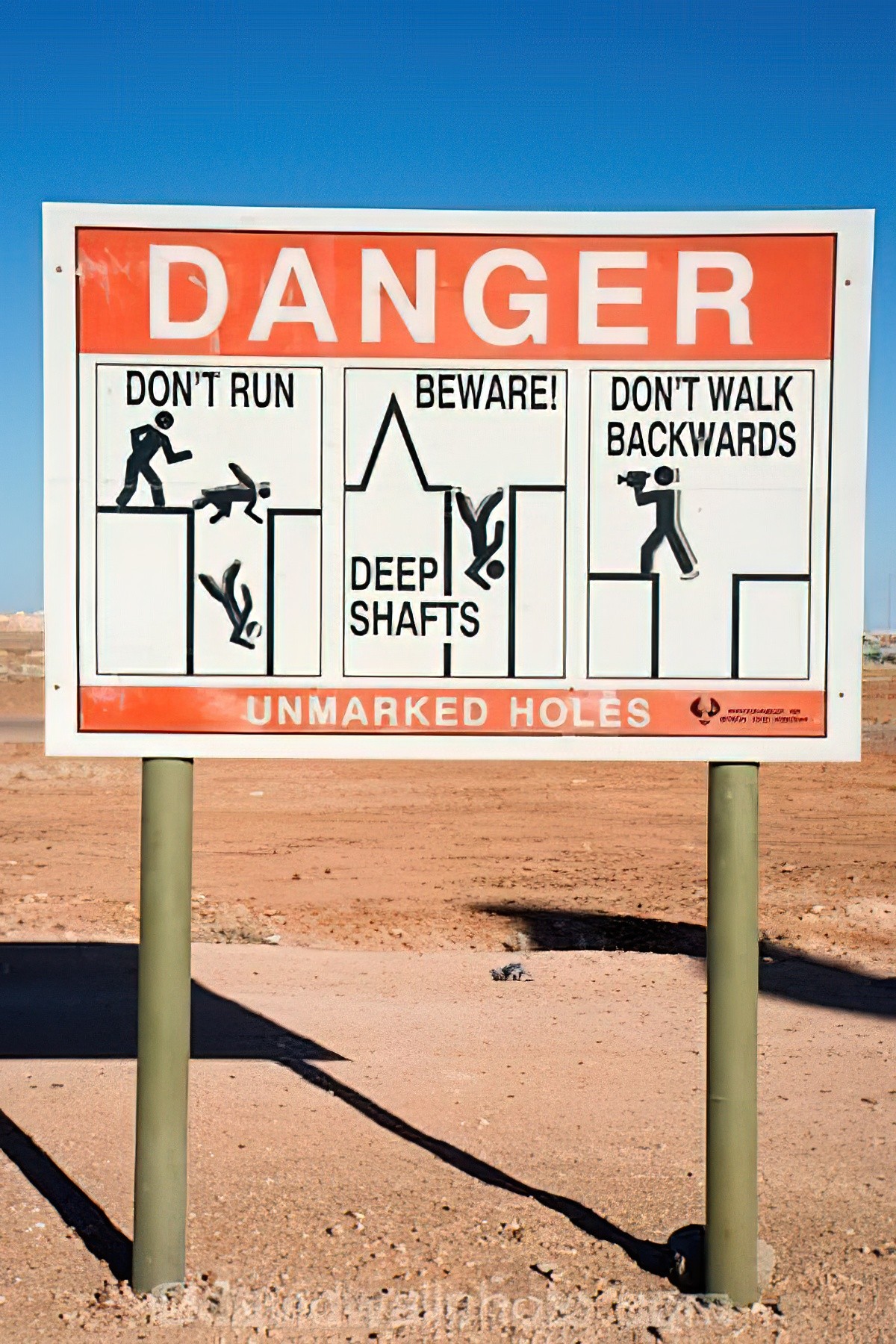
CREATING A THREATENING AMBIANCE
There are many ways to do this.
Word usage and imagery:
- deviled eggs
- a sign saying ‘caution’
- deep chambers… some the size of a coffin
- not enough greenery to make any sort of a cushion over the rubble below
Telling the reader that this place is not threatening at all, which invokes reverse psychology:
- The entrance to the woods looked quite ordinary and non-threatening.
Narrative insertions which are obviously the result of hindsight:
- They said O.K., and he proceeded, carrying the picnic basket and apparently believing that no further fatherly warning was necessary.
Munro even uses the horror trick of scaring us then revealing that nothing has happened, yet:
He gave a cry of arrival and display, and the boys hooted with true astonishment.
(The husband is simply marveling at the view.) This functions like a jump scare.
THE SYMBOLISM OF ALTITUDE
Munro is using the full space when painting the arena of “Deep Holes”. She uses the height of the bluff juxtaposed against the depth of the holes.
The entrance to the woods looked quite ordinary and unthreatening. Sally understood, of course, that these woods were on top of a high bluff, and she expected a daunting lookout somewhere. She did not expect the danger that had to be skirted almost immediately in front of them.
Deep chambers, really, some the size of a coffin, some much bigger than that, like rooms cut out of the rocks. Corridors zigzagging between them, and ferns and mosses growing out of the walls. Not enough greenery, however, to make any sort of cushion over the rubble below. The path went meandering between them, over hard earth and shelves of not quite level rock.
STORY STRUCTURE OF “DEEP HOLES”
SHORTCOMING
Alice Munro is an expert at depicting the emotional labour of motherhood. I’m sure many women will relate to it immediately, and men should understand it too, since she depicts Sally’s interiority so well.
Sally’s shortcoming, therefore, is that she exists in service to her husband and family. Her husband is typical of his era — he considers the work of organising a picnic the wife’s job, but that extends far beyond just preparing the picnic. It extends to jobs he isn’t even aware exist: Remembering who likes how much mustard on their sandwich then divvying them up accordingly. The worry of danger nearby and the tug between being an ‘overly anxious mother’ and letting the children run free.
These attitudes are conveyed via details such as who has packed the picnic, who carries the baby, who is worried about the boys, who looks at who in an attempt to keep the marriage alive. (Sally, in every instance.) The husband’s attitude towards breast-feeding is sadly still common today. Except now, unlike then (my mother’s era), women are roundly shamed for ‘choosing’ not to breastfeed. At least in the era after formula became available, switching to formula was considered a viable option. (This is not an argument in favour of formula — breastmilk is clearly the healthier choice when breast-havers are able to offer it.)
Sally’s connection to her family is shown in other, subtle ways. When Sally wonders why ‘deep-holes’ is hyphenated on the carpark sign, I read that as Sally being joined, literally in the case of the baby, to her family. Sally and each of her children have not yet bifurcated as people.
DESIRE
Mothers and wives in Munro’s short stories are not permitted world-changing desire lines — theirs are quiet desires which allow these women to continue fulfilling the roles they have been channeled into, without rocking the patriarchal boat. The women are never blamed for the milieu which formed them. They are not expected to be ‘strong female characters’. Finding a way to live happily as a wife and mother is its own kind of strength.
Clearly, however, and Sally would love to reconnect with her estranged son.
OPPONENT
Sally’s son in “Deep Holes” is very much a Chris McCandless archetype — bright, unmotivated by sex (probably asexual — an orientation rarely depicted in fiction). He fancies himself spiritual, is scathing, reckless with his own health and dismissive of the people who have given him the most.
This personality type is fascinating, and I’m not surprised Jon Krakauer wrote an entire book on Chris McCandless. We never really do learn who McCandless is, though. Such men are unknowable, and that’s their aim.
However, Krakauer did see himself in McCandless. As a young man he felt himself invincible, evidenced by his attitude to rock climbing, a sport which shaped and filled his youth. The estranged son in Munro’s story is perhaps an exaggerated version of young men everywhere, who almost always distance themselves from their mothers to a degree.
PLAN
This is an example of a story in which the Opponent drives the Plan.
Kent calls the shots, as the daughter points out. Sally has no choice but to wait for her son to get in touch. When he does, of course she takes up the opportunity to meet him. Even then, she goes along only to see what she can make of the meeting.
BIG STRUGGLE
Alice Munro’s Battle scenes often take place in kitchens, or sitting down in a living room. So it is here. We could parse this scene onto a chase in an action film, but of course it’s nothing like that on the surface. When Sally thinks of running away, and knows she couldn’t jump the fence at the back, and when the son comes back after a full half-hour, surprised to see his own mother still there, this is a more moving kind of chase than in any action film I’ve ever seen. Munro has subverted the chase scene.
ANAGNORISIS
Munro uses a few tricks to lead us to Sally’s Anagnorisis, which is this: She may never patch things up with her son. It will always be a ‘maybe’. He is not the son that she knew. He even has a different name.
Therefore, Sally must learn to live with this distance. She will continue to imagine herself on an island. She will hope that Kent has found his own island of happiness as well.
At the point in a story when a character has a Anagnorisis, there is often the feeling that the main character has become very small, the landscape has become very large, and also that we see them from above, as if in an establishing shot at the beginning of a movie. In other words, the character (as we do) now has the ‘bigger picture’.
SYMBOLISM OF THE MINIATURE
Alice Munro turns Sally into a tiny figure within a vast landscape:
She reminded him that she knew nothing about rocks, and he said never mind that, he could use her for scale, in the photographs.
So she became the small figure in black or bright clothing, contrasting with the ribbons of Silurian or Devonian rock or with the gneiss formed by intense compression, folded and deformed by clashes of the North American and the Pacific plates to make the present continent.
This is a woman who has lived her entire life in service to her family, so there’s the feminist reading, of course. A good writer makes statements like that. But a great writer such as Alice Munro stretches the metaphor further.
She sort of flips it, actually. By the end of the story Sally has regained control by taking the juxtaposed isolation/extreme closeness of motherhood and turning it into a neat psychological trick she can use in service of her own happiness.
By the way, The Overview Effect goes hand-in-hand with the miniature.
THE OVERVIEW EFFECT
Since first noticing it, I keep seeing The Overview Effect utilised in story, especially in short form storytelling, where it is particularly useful in creating the illusion of a vast time and space (within a very short time and space on the page). The Overview Effect is linked to the miniature effect utilised in the same paragraph (above). Here’s the continuation:
Gradually [Sally] learned to use her eyes and apply her knowledge, till she could stand in an empty suburban street and realize that far beneath her shoes was a crater filled with rubble that had never been seen, because there had been no eyes to see it at its creation or through the long history of its being made and filled and hidden and lost.
Philosophers use another word for this: The sublime.
NEW SITUATION
“Deep Holes” is on one level a tragedy, because Sally does not get what she desires. She does not reconnect with her son. The meeting has driven them further apart.
Now she must live with that.
Like many of Munro’s older woman characters, Sally has developed psychological tricks to help her cope with her inferior, older-woman status and widowed situation — she has a lifelong habit of imagining herself on an island. In narrative, islands are pretty much always heavy with symbolism.
In her imagination, these islands are real, geolocatable places. As we are told earlier in the story, she is careful not to make up any of the details. If she hews her imagination to reality, these islands serve her better. Also, I believe it’s important she never actually visit those islands. They’re better off existing as fernweh.
How is Sally using the imagined islands? As the remainder of this story makes clear, these islands are a psychological trick which help Sally to remain her own person, if only inside her head. This ability to separate herself from members of her family, even after providing the most care anyone can ever give another person — a womb, the breast, remembering whether you like mustard on your sandwich or not — becomes especially necessary when one of her sons shucks her off.
Sally’s ‘separateness’ is symbolised, quite obviously, by the lasagne-for-one she eats after the disappointing, enraging visit:
She heats up a single serving of lasagna. She buys these separated, precooked, and frozen portions now. They are quite good and not too expensive when you think that there’s no waste.
In the same paragraph we see Sally continues with her own life, and her own life is full, because she is now reaping the rewards of a lifetime in service to others: She has friends who call and leave messages. She enjoys small luxuries such as a glass of wine with her meal.
And the final paragraph reveals: Sally looks to people even older than herself, who have learned to live on their own islands, because they have had to.
PARENT-CHILD ESTRANGEMENT
Alice Munro is one of the few writers who deals with the topic of parent-child estrangement in a realistic, emotionally literate way. Most stories of estrangement, though rare compared to the rates in real life, are about relationships which split after one massive event which puts a clear end to it: Stories like this one are taken up by the media. But parent-child estrangement is most often a very difficult thing to describe and very difficult to ‘dramatize’ in a story without the One Big Moment.
OTHER STORIES IN MUNRO’S TOO MUCH HAPPINESS COLLECTION
- “Dimensions” —
- “Fiction” —
- “Wenlock Edge” —
- “Deep Holes” —
- “Free Radicals” —
- “Face” —
- “Some Women” —
- “Child’s Play” —
- “Wood” also in the November 24, 1980 edition of The New Yorker
- “Too Much Happiness” —
